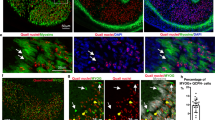Abstract
Community effects are believed to play an important role in the patterning of many tissues during development. They involve an interaction between neighbouring equivalent cells that is necessary for them to proceed to their fully differentiated state. However, the mechanisms underlying these effects remain unclear. In this paper, diffusion-based mathematical models are constructed and analysed in order to study possible mechanisms for the community effect inXenopus muscle differentiation. These models differ from each other in the assumptions that are made about the nature of an inhibitory effect that ectodermal tissue has been observed to have on muscle differentiation. It is possible to construct consistent models based on all the forms of inhibition considered. However, each model requires the diffusible factors on which it is based to have different properties. The current data from tissues reaggregate experiments are insufficient to determine the mechanisms underlying the community effect; the work presented here suggests that quantitative analysis of a further series of reaggregate experiments will make it possible to distinguish between the proposed mechanisms.
Similar content being viewed by others
References
Altshuler, D. and C. Cepko. 1992. A temporally regulated, diffusible activity is required for rod photoreceptor development in vitro.Development 114, 947–957.
Altshuler, D., J. J. Turco, J. Rush and C. Cepko. 1993. Taurine promotes the differentiation of a vertebrate retinal cell type in vitro.Development 119, 1317–1328.
Babloyantz, A. 1977. Self-organization phenomena resulting from cell-cell contact.J. Theor. Biol. 68, 551–561.
Cooke, J., K. Symes and E. J. Smith. 1989. Potentiation by the lithium ion of morphogenetic responses to aXenopus inducing factor.Development 105, 549–558.
Cooke, J. 1995. Morphogens in vertebrate development: how do they work?BioEssays 17, 93–96.
Cossu, G., R. Kelly, S. Di Donna, E. Vivarelli and M. Buckingham. 1995. Myoblast differentiation during mammalian somitogenesis is dependent upon a community effect.Proc. Natl. Acad. Sci. U.S.A. 92, 2254–2258.
Crick, F. H. C. 1970. Diffusion in embryogenesis.Nature 225, 420–422.
Green, J. B. A., J. C. Smith and J. C. Gerhart. 1994. Slow emergence of a multithreshold response to activin requires cell-contact-dependent sharpending but not prepattern.Development 120, 2271–2278.
Gurdon, J. B. 1988. A community effect in animal development.Nature 336, 772–774.
Gurdon, J. B., K. Kao, K. Kato and N. D. Hopwood. 1992. Muscle gene activation inXenopus requires intercellular communication during gastrula as well as blastula stages.Development 116, 137–142 (Suppl.).
Gurdon, J. B., K. Kato and P. Lemaire. 1993a. The community effect, dorsalization and mesoderm induction.Curr. Opin. Gen. Dev. 3, 662–667.
Gurdon, J. B., P. Lemaire and K. Kato. 1993b. Community effects and related phenomena in development.Cell 75, 831–834.
Gurdon, J. B., E. Tiller, J. Roberts and K. Kato. 1993c. A community effect in muscle development.Current Biology 3, 1–11.
Hemmati-Brivanlou, A. and D. A. Melton. 1994a. Inhibition of activin receptor signaling promotes neuralization inXenopus.Cell 77, 273–281.
Hemmati-Brivanlou, A., O. G. Kelly and D. A. Melton. 1994b. Follistatin, an antagonist of activin, is expressed in the Spemann organizer and displays direct neuralizing activity.Cell 77, 283–295.
Ho, R. K. 1992. Cell movements and cell fate during zebrafish gastrulation.Development 116, 65–73 (Suppl.).
Hopwood, N. D., A. Pluck, J. B. Gurdon and S. M. Dilworth. 1992. Expression of XMyoD protein in earlyXenopus laevis embryos.Development 114, 31–38.
Jouanneau, J., G. Moens, Y. Bourgeois, M. F. Poupon and J. P. Thiery. 1994. A minority of carcinoma cells producing acidic fibroblast growth factor induces a community effect for tumor progression.Proc. Natl. Acad. Sci. U.S.A. 91, 286–290.
Kato, K. and J. B. Gurdon. 1994. An inhibitory effect ofXenopus gastrula ectoderm on muscle cell differentiation and its role for dorsoventral patterning of mesoderm.Developmental Biology 163, 222–229.
Lewis, J., J. M. W. Slack and L. Wolpert. 1977. Thresholds in development.J. Theor. Biol. 65, 579–590.
Saxon, L. and S. Toivonen. 1962.Primary Embryonic Induction, London: Logos Press.
Shymko, R. M. and L. Glass. 1976. Cellular and geometric control of tissue growth and mitotic instability.J. Theor. Biol. 63, 355–374.
Slack, J. M. W. 1991. The nature of the mesoderm inducing signal inXenopus. A transfilter study.Development 113, 661–669.
Smith, J. C., V. Cunliffe, M-A. J. O'Reilly, S. Schulte-Merker and M. Umbhauer. 1995.Xenopus Brachyury.Sem. Dev. Biol. 6, 405–410.
Stüttem, I. and J. A. Campos-Ortega. 1991. Cell commitment and cell interactions in the ectoderm ofDrosophila melanogaster.Development 113, 39–46 (Suppl. 2).
Symes, K., C. Yordán and M. Mercola. 1994. Morphological differences inXenopus embryonic mesodermal cells are specified as an early response to distinct threshold concentrations of activin.Development 120, 2339–2346.
Weintraub, H. 1993. The MyoD family and myogenesis: redundancy, networks and thresholds.Cell 75, 1241–1244.
Weston, M. J. D., K. Kato and J. B. Gurdon. 1994. A community effect is required for amphibian notochord differentiation.Roux's Arch. Dev. Biol. 203, 250–253.
Wilkinson, D. G. 1995. Genetic control of segmentation in the vertebrate hindbrain.Persp. Dev. Neurobiol. 3, 29–38.
Wilson, P. A. and D. A. Melton. 1994. Mesodermal patterning by an inducer gradient depends on secondary cell-cell communication.Current Biology 4, 676–686.
Yuen, I. S. and R. H. Gomer. 1994. Cell density-sensing inDictyostelium by means of the accumulation rate, diffusion coefficient and activity thresholds of a protein secreted by starved cells.J. Theor. Biol. 167, 273–282.
Author information
Authors and Affiliations
Rights and permissions
About this article
Cite this article
Monk, N.A.M. The community effect and ectoderm-mesoderm interaction inXenopus muscle differentiation. Bltn Mathcal Biology 59, 409–425 (1997). https://doi.org/10.1007/BF02459458
Received:
Accepted:
Issue Date:
DOI: https://doi.org/10.1007/BF02459458




